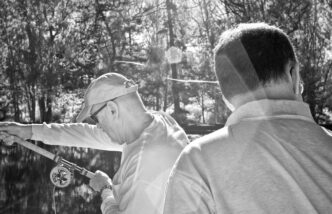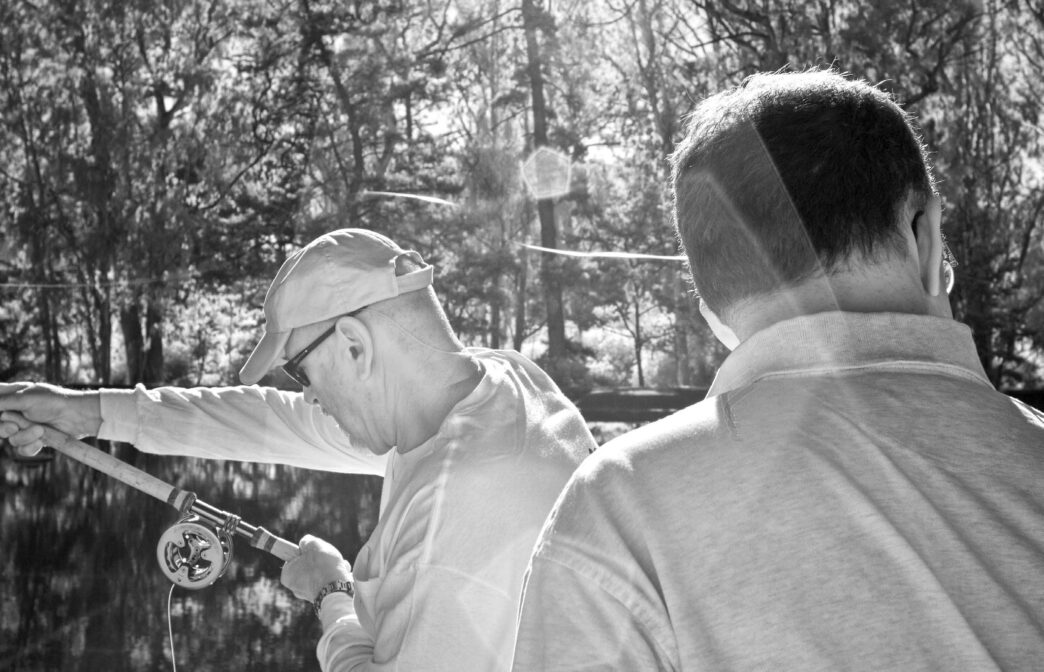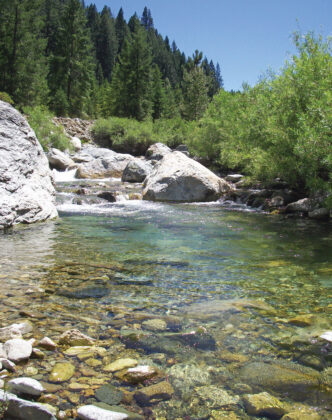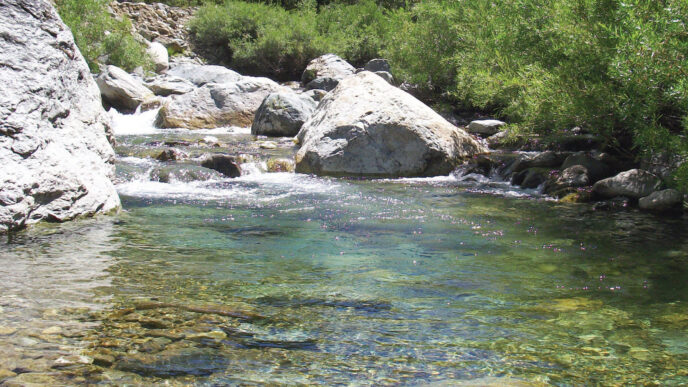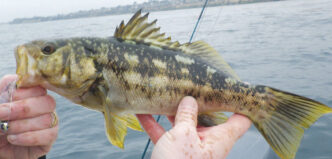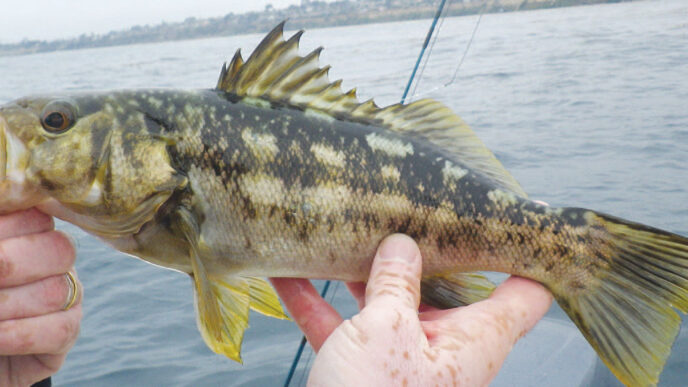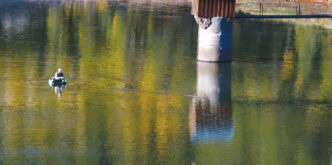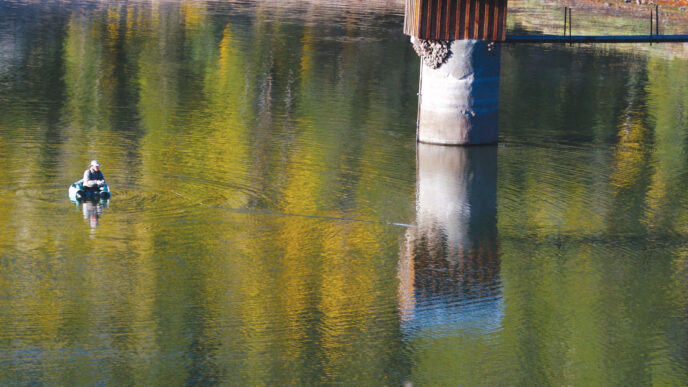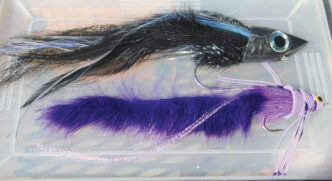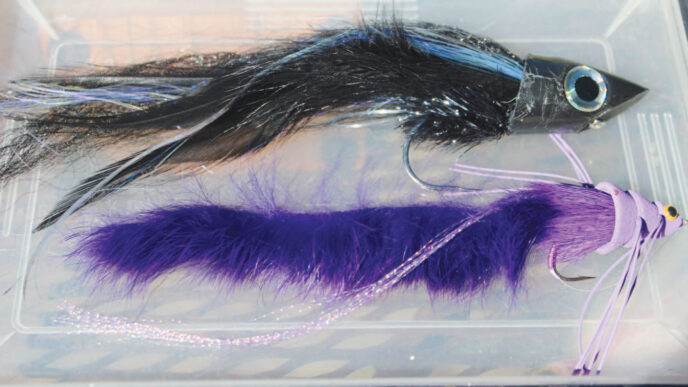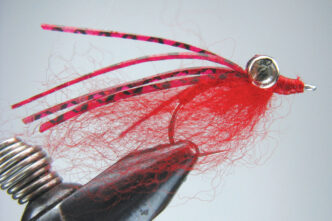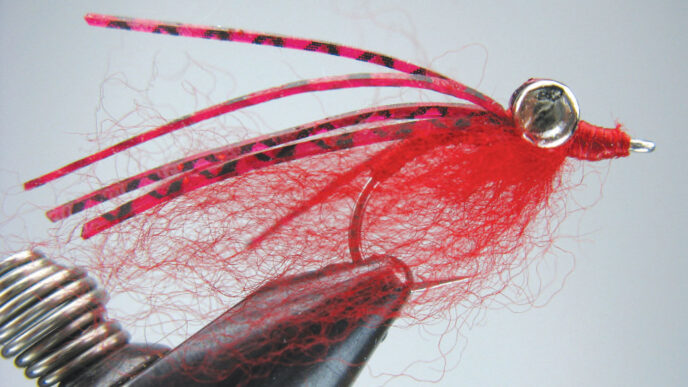What a difference a decade or so makes. It wasn’t so long ago that the standard fly tackle for steelhead anywhere in the Northwest was considered to be a singlehanded 8-1/2-foot to 9-1/2-foot rod for a 7-weight to 9-weight weight-forward line or the appropriate shooting head. Today, even on a small stream such as California’s Trinity River, most anglers will be carrying two-handed rods of 10-1/2 to 13 feet and will be casting contemporary Spey lines or heads whose business ends weigh as much as single-handed tarpon lines. So much for the notion that delicacy matters. Is the single-handed steelhead rod as dead as the wicker creel?
Maybe this Spey thing is simply a fashion choice — a productive one, of course, one that’s captured the imagination of gear-addled anglers looking for an edge, goosed along by savvy tackle marketers who know that fly fishers buy anything that offers a reasonable argument for better results. Add in the allure of a new group identity built around fishing, evaluating, and discussing the new gear and around new or reworked casting techniques that promise unheard-of distances. Then finish off with a specialty vocabulary with terms such as “D loop, “snap T,” “bloody L, “Perry poke,” and “sustained anchor” that excludes or at least mystifies the uninitiated.
Get a two-handed rod, the pitch goes, and you’ll not only cover more water more easily and catch more fish, but you’ll be on the cutting edge, part of an elite group that leaves the plodding single-handed crowd behind. Meanwhile, sings the amen chorus from the tackle companies, we’ll sell you rods and lines that we’re still in the process of developing, and if you have to buy something new and better every six months, well . . . that’s fishing for you.
OK, that’s a bit cynical, even for me. You can fool most of the people most of the time, but the hard-core guys who fish the Clearwater, or the Snake, or the lower Eel, or the big rivers of British Columbia wouldn’t be using gear that didn’t give them every possible edge. It’s no secret that the majority of them have gone to two-handed rods. Bob Pauli, one of the very capable guys who developed the exceptional Spey-casting program at the Golden Gate Angling and Casting Club, someone who fishes British Columbia every year and also loves spring creek fishing with light-line single-handed rods, puts it this way: “A significant percentage of the advantages of Spey accrue to rod length, with longer being better: safety (the fly is farther from the angler than with shorter rods); safety (longer distance eliminates most deep wading); distance with ease, mending and fly control during the swing; less fatigue; the ability to cast far when absolutely backed up against an obstruction.”
All those are telling arguments for double-handed rods. But that’s not the end of the story. Experienced anglers also agree that while fishing deep might not be the most exciting way to catch a steelhead, it’s frequently the most productive. And double-handed rods that can handle heavy sinking tips will put a fly down deep, at distance and under control, better than single-handed rods fishing lighter tips.
Lani Waller, whose videos on steelhead fishing have walked a generation of anglers through the basics and who has lingering affection for single-handed rods and rarely fishes a double-hander over 11 feet, points out that the “ ‘weakness,’ if it could be called that, of a single-handed rod is that they are a little more difficult to cast using the very large and often heavily weighted steelhead tube and stinger-style of flies that are currently in vogue.” Of course, he also notes that “I know for a fact that you don’t need those kinds of flies to catch fish, but everyone is using them, including me.”
Gary Anderson, who builds high quality custom rods on the banks of Oregon’s Rogue River, points out that it’s not simply making long casts with less effort that favors double-handed rods. “Cast all day long making long casts with a single-handed rod, and you’re going to be a lot more tired and worn down than if you used both hands with a Spey rod of some kind.” So… make long casts with less effort.
Fish deeper with bigger flies. Get the advantage of rod length in mending. Fish water that provides no room for a back cast. Fish more safely, because you don’t have to wade as deep. What’s not to like?
Not surprisingly, there isn’t universal agreement among steelhead anglers that all those advantages make the choice of a double-handed rod inevitable. This is fishing after all, a subject as contentious as religion and politics.
One objection that some anglers have to Spey rods is that the act of casting disturbs the water and spooks fish. I think that’s more likely to happen when an angler makes a bad Spey cast with a lousy anchor than when a cast is well executed, but even a good cast would be a problem when fishing a quiet tidal pool where fish are podded up. Even water-loading a shooting head with a single-handed rod (that is, roll casting a sinking head from a downstream hang to where it touches down ahead of you in order to load the rod when picking up line) will get you evil looks on some coastal winter steelhead runs. But you’ll get more than evil looks if you ease into a lineup on the Russian or the Eel with a double-hander and start to work out line with a sweeping D loop to the side: there’s simply too little room between anglers for that. However, these are specialized situations, not common to most inland steelhead fisheries.
Only a couple of years back, the 14-foot rod was the standard double-hander, casting a full line of one kind or another, rather than some sort of head. But lately, what we’re seeing is a shift toward the shorter end of the spectrum of two-handed rod lengths. That owes in part to the fact that shorter rods are lighter in the hand. It’s also because of changes in techniques that favor or support the shorter lengths and in part because the smaller rivers that many anglers fish tend to favor or allow for shorter rods. You don’t need a 14-footer to fish the Trinity or the Applegate. Tim Rajeff of Echo Rods and Airflo lines notes: “With the advent of Skagit and shorter two-hand lines, rods have followed and become shorter. We sell few, if any, 14-foot or 15-foot rods. The average two-hand rod is between 12 feet 3 inches and 13 feet 4 inches.”
And Gary Anderson points out the obvious: “Even a D loop needs back-cast room, so if you’re fishing a river where you’re constantly backed up into the willows or bank, a shorter rod, utilizing a D loop that doesn’t extend quite as far back, is going to be an advantage.”
As with Tim Rajeff ’s Echo rods, the vast majority of the two-handers that Anderson sells don’t go much beyond 13 feet in length. Maybe the length from 12 feet 6 inches to 13 feet 6 inches is a sweet spot where the considerable advantages of a double-hander outweigh its occasional disadvantages.
Some anglers disagree that the long two-handed rod is easier to fish than a single-handed rod. Despite the fact that casting a Spey rod distributes the load between two hands and arms, length is a lever working against you just as much as it’s working for you. If there’s 10 or 11 feet of rod in front of your top hand as you follow a fly and line down a run or when you’re trying to adjust a drift with mends, it can require more effort than you expect. Here’s Lani Waller again, whose preference is for double-handed rods around 11 feet: “the longer rods (12 to 15 feet) feel heavy, slow, lethargic, and cumbersome and they don’t have . . . ‘the lightness of being’ in them that I like. They don’t feel like a fly rod to me. They feel like a heavy pole. The ‘vibrations’ and actions feel slow, heavy, and lethargic.”
And of course, even a 12-foot rod can be a pain just to carry around. Try going down a wooded hillside to the river without breaking it down, or scrambling around outcroppings that can’t be waded. Not fun.
Landing fish with a double-hander is another issue. On this subject, angling writer Ernest Schwiebert once wryly observed: “Trust the British to invent a sport that requires a servant.” Someone to net or tail a fish is a real help with a Spey rod, because it can be a challenge to capture it on your own while staying connected to the rod. You might be able to lead a fish up onto the gravel, but that’s not going to do the fish any good if you plan to release it. Of course, if steelhead really are the fish of a thousand casts, landing fish may not be much a problem, because you may not have the opportunity very frequently.
Then there’s the “switch” rod, a term coined by Oregon rod builder Bob Meiser to describe a rod of 10-1/2 feet or thereabouts, with a grip configured so that you can cast either overhead (with a back cast) or “switch” and execute Spey casts using the same line, but in most cases with both hands. That concept gradually morphed into a rod that was billed as letting you cast either single-handed or double-handed. Switch rods gained initial popularity with anglers who were uncertain about whether they’d be able to use a longer rod or master what seemed to be difficult Spey casting techniques. Competent Spey casters saw them as neither fish nor fowl: too long to be comfortable as single-handers and too short to be a really good Spey rod.
For Bob Pauli, the term “switch rod” is meaningless:
It is illogical to differentiate doublehanded rods that are 11.99 feet long and shorter from those 12.00 feet long and longer, when all doublehanded rods use identical casting techniques. Why is there not a different name for shorter or longer single-handed fly rods? The key thing to remember is that two hands are always better than one and rod length is strictly a matter of personal preference Speypages.com (the fine Web site devoted to the practice) users overwhelming report using two hands with their switch rods almost exclusively.
What people who like switch (or shorter Spey) rods discovered is what anglers found they liked about longer graphite rods in the 1980s: more control and distance without much more effort than with shorter rods. Most of us can make longer casts with switch rods than with most single-handed rods, particularly casting double-handed. The extra length and relatively light weight also aid in line manipulation. If you’re fishing an indicator, it ’s generally easier to throw stack mends into a drift with an 11-foot rod than with a 13-footer. You can also still strip strike pretty effectively with an 11-footer, something that can be difficult with a longer Spey rod. Whether the long rod or the short rod is more effective in playing and beating a fish is up for debate. The fish has more leverage on you with the long rod, but by the same token, there’s more spring against which it has to fight.
Some folks also like the sense of connection that shorter long rods provide, Lani Waller is one of them. They “feel like a fly rod. Nothing seems lost, and I can feel every inch of the rod performing and being a part of my fingers and hands, my arms and my casting style. In other words, they are still small enough and light enough for me to feel and connect with.”
So what about single-handed rods? Are they a dead category for steelhead fishing? Lots of us will answer with a resounding No. I’ve mentioned the place for single-handed rods in fishing tidewater pools or slow, deep pools, or in casting in proximity to other anglers. They’re simply more efficient in that situation. On rivers such as the Trinity and upper Klamath, there’s a lot of water that can be effectively covered with a 9-foot rod. But fly fishing, it seems to me, is not simply about being efficient, but also about challenging ourselves with our tackle.
You won’t generally cast as far with a single-handed rod or get down deep a very long way out with a 3-inch-long, heavily weighted articulated leech. You may use more effort, and you may not be able to mend as far off, although for me, the longer the rod, the less accurate I find my mends to be. But that may not matter. I expect that as many steelhead are taken at 75 feet as at 100, and a single-handed rod in the hands of a competent caster ought to be able to do that all day.
Affection for single-handed rods may in part be a generational thing. Many of us who grew up fly fishing in the 1960s and 1970s still equate single-handed rods with the essential experience of fly fishing. I recall talking to Mel Krieger a couple of months before he died. An early advocate of double-handed rods and Spey casting, he said he’d done an experiment, fishing a Patagonia sea trout river on one day with a Spey rod and the next day with a 9-foot 8weight. Which did he prefer, I asked? “The single-hander was a better experience,” he told me. There’s something addictive about the experience of casting any rod competently, and a good Spey cast that bounces line off the reel at 100 or more feet is exceptionally satisfying. But I still get more pleasure going through a run with my well-used 9-1/2-foot 8-weight than I do with a 12-foot 6-inch 400-grain Scandi setup. I’ll be fooling with an 11-foot double-hander this fall and suspect I’ll like that better, too.
Still, you have to wonder what the guys fishing the West’s big rivers in the 1950s would have said if you’d have given them a light graphite 13-footer with a Skagit head and a 10-foot tip of ultra fast sinking T-14. I expect a lot of them would have glommed onto it faster than a seal grabs a tired salmon. They were, after all, the innovators who rubbed graphite into their braided lines to get them to sink, adopted shooting heads and mono running line, and fished untraditional weighted flies to get down to big winter fish. But then there were also guys such as legendary Washington steelheader and fly tyer Walt Johnson, who fished, in equal defiance of custom, rods as short as 6 feet for 3-weight and 4-weight lines on the Stilliguamish and the North Umpqua. Walt thought it was more sporting. Does anybody ever get it right?
Every choice we make as steelheaders — choosing a fly over drifting roe or pulling plugs, tying on a skater instead of a weighted fly or traditional wet, fishing a floating line instead of a sink tip or head or using an indicator, choosing a Spey rod instead of a single-hander — comes with limitations as well as advantages. From where I sit, if a rod talks to me and I like what it is saying, I am going to fish it, regardless of how many hands it takes to cast it.



